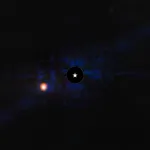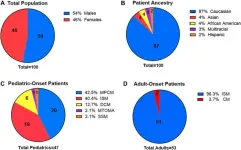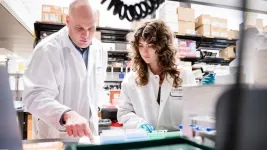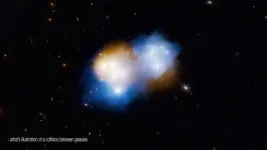(Press-News.org) Acute myeloid leukaemia is one of the deadliest cancers. Leukaemic stem cells responsible for the disease are highly resistant to treatment. A team from the University of Geneva (UNIGE), University Hospital of Geneva (HUG), and Inserm has made a breakthrough by identifying some of the genetic and energetic characteristics of these stem cells, notably a specific iron utilisation process. This process could be blocked, leading to the death or weakening of these stem cells without affecting healthy cells. These results, published in Science Translational Medicine, pave the way for new therapeutic strategies.
Acute myeloid leukaemia (AML) is the most common blood and bone marrow cancer in adults. Caused by an increase in immature cells that rapidly destroy and replace healthy blood cells (red and white blood cells and platelets), AML is lethal in half of those affected under the age of 60, and in 85% of those over that age.
This unfavorable prognosis may be due to the presence of so-called ‘‘dormant’’ or ‘‘quiescent’’ leukaemic stem cells (LSCs), which evade chemotherapy. Often invisible, these cells can ‘‘wake up’’ and reactivate the disease after an apparently successful course of treatment. Developing therapies that target these cells is therefore a major research challenge. However, the mechanisms controlling them are poorly understood.
By identifying genetic and metabolic characteristics specific to LSCs, a team from the UNIGE, HUG, and Inserm is providing new insights, as well as ways of combating the disease. These results, published in Science Translational Medicine, pave the way for a new therapeutic target and its clinical application.
A distinctive genetic signature
‘‘Using advanced bioinformatics techniques and in collaboration with the team of Dr Petros Tsantoulis from the Department of Oncology and Precision Oncology at the HUG, we first established that these quiescent cells contain a unique genetic signature consisting of 35 genes. When we used this signature in large clinical databases of patients with AML, we were able to show that this signature was strongly linked to the prognosis of the disease,’’ explains Jérôme Tamburini, associate professor in the Department of Medicine and the Centre for Translational Research in Onco-haematology (CRTOH) in the UNIGE Faculty of Medicine and at the Swiss Cancer Center Léman (SCCL), staff physician in the Division of Oncology at HUG, who led this research.
Blocking a specific nutrient
The study also highlights a metabolic difference between dormant and active leukaemic stem cells. In general, to survive, cells trigger chemical reactions that enable them to break down nutrients and thus produce energy. This also involves ‘‘autophagy’’, a process that allows cells to recycle cellular components to generate new ones and to provide energy in case of a lack of external nutrients. Scientists have discovered that dormant leukaemic stem cells depend on ‘‘ferritinophagy’’, a specific form of autophagy targeting ferritin, the main iron storage molecule.
‘‘This process is mediated by a protein called NCOA4. It controls the availability of iron in cells. By inhibiting it, either genetically or chemically, we observed that leukaemia cells, especially dormant stem cells, are more likely to die, whereas healthy blood stem cells remain intact,’’ reveals Inserm researcher Clément Larrue, a former post-doctoral researcher in Jérôme Tamburini’s group, currently a post-doctoral researcher at the Toulouse Cancer Research Center, and first author of the study.
Towards clinical trials
Experiments conducted with mouse models have confirmed that blocking the NCOA4 protein reduces tumour growth, viability and self-renewal of leukaemic stem cells. Targeting ferritinophagy through this inhibition pathway could therefore be a promising therapeutic strategy. The compound used to block NCOA4 is in the early stages of development for future clinical trials, under the direction of one of the study’s co-authors, Jun Xu, a professor at Sun Yat-Sen University in China.
The next step for the UNIGE team will be to explore further the mechanisms of ferritinophagy and its association with mitophagy, another key mechanism in the regulation of LSCs. This new stage of research is supported by the Swiss Cancer League.
END
Fighting leukemia by targeting its stem cells
By identifying mechanisms unique to leukemia-causing cells, a French-Swiss team has discovered a new way to fight the disease
2024-07-24
ELSE PRESS RELEASES FROM THIS DATE:
NASA’s Webb images cold exoplanet 12 light-years away
2024-07-24
An international team of astronomers using NASA’s James Webb Space Telescope has directly imaged an exoplanet roughly 12 light-years from Earth. The planet, Epsilon Indi Ab, is one of the coldest exoplanets observed to date.
The planet is several times the mass of Jupiter and orbits the K-type star Epsilon Indi A (Eps Ind A), which is around the age of our Sun, but slightly cooler. The team observed Epsilon Indi Ab using the coronagraph on Webb’s MIRI (Mid-Infrared Instrument). Only a few tens of exoplanets have been directly imaged previously by space- and ground-based observatories.
“Our prior observations of this system have been more indirect measurements ...
Prevalence and impact of the KIT M541L variant in patients with mastocytosis
2024-07-24
“This study uniquely examines the prevalence and impact of the KIT M541L variant in both adult and pediatric patients with mastocytosis further stratified by disease variant.”
BUFFALO, NY- July 24, 2024 – A new research paper was published in Oncotarget's Volume 15 on July 22, 2024, entitled, “Prevalence and impact of the KIT M541L variant in patients with mastocytosis.”
Activating mutations in KIT, particularly D816V, have been associated with mastocytosis. Additionally, expression of heterozygous KIT M541L has been primarily ...
Experts outline considerations to deploy AI in radiology
2024-07-24
Artificial Intelligence (AI) tools can play a key role in medical imaging if radiologists trust in their design, deploy them with adequate training and establish clear guidelines regarding clinical accountability, according to a recently published Special Report in Radiology: Artificial Intelligence, a journal of the Radiological Society of North America (RSNA).
RSNA and the Medical Image Computing and Computer Assisted Intervention (MICCAI) Society have led a series of joint panels and seminars focused on the present impact and future directions of AI in radiology. These conversations ...
Johns Hopkins Medicine’s Center for Inherited Disease Research renews 7-year award for up to $98 million
2024-07-24
FOR IMMEDIATE RELEASE
With renewed funding of up to $98.8 million for seven years, Johns Hopkins Medicine scientists will continue to be a worldwide resource for discovering the genes and their variations that contribute to human disease.
Leaders of the Johns Hopkins Center for Inherited Disease Research, established in 1996, received the fourth consecutive renewal for up to $98,880,900 in funds from a consortium of 10 institutes at the National Institutes of Health. The seven-year award is divided between ...
Preventing brain damage in preterm babies
2024-07-24
SAN FRANCISCO—Mark Petersen, MD, has seen firsthand the devastating effects of brain bleeds in premature babies. It’s an exceedingly common condition that affects up to 20 percent of infants born before 28 weeks of gestation, bringing an increased risk for developmental delays and autism.
“As a neonatologist and neuroscientist, it’s frustrating that we don’t have any treatments to counteract the harmful effects of bleeding in the developing brain, even though we know it often leads to lasting problems,” says Petersen, director ...
JNM maintains strong metrics in 2023 Journal Citation Reports
2024-07-24
Reston, VA—The Journal of Nuclear Medicine (JNM)—the flagship publication of the Society of Nuclear Medicine and Molecular Imaging—has maintained its status as one of the top medical imaging journals worldwide, according to new data just released in Clarivate's 2023 Journal Citation Reports. With an impact factor of 9.1, JNM saw increases in its five-year impact factor, journal citation indicator, and article influence score, among other categories.
“This is an exciting time for nuclear medicine, with ground-breaking advances in molecular imaging, theranostics, artificial intelligence, and other areas,” said Johannes Czernin, MD, ...
New study determines incidence of and risk factors for hepatitis C virus reinfection among men with HIV, offers new insight on transmission
2024-07-24
Paper Title: Hepatitis C Virus Reinfection Among Men Who Have Sex With Men With HIV in New York City
Journal: Clinical Infectious Diseases, July 2024
Authors: Daniel S. Fierer, MD, Professor of Medicine (Infectious Diseases) at the Icahn School of Medicine at Mount Sinai, and other coauthors.
Bottom Line: This study provides new perspectives on transmission of hepatitis C virus (HCV), a virus that infects the liver and can be transmitted during injection of drugs, among men who have sex with men (MSM).
How: The researchers performed a prospective cohort study in New York City of MSM with HIV who had cleared ...
Dark matter flies ahead of normal matter in mega galaxy cluster collision
2024-07-24
Astronomers have untangled a messy collision between two massive clusters of galaxies in which the clusters' vast clouds of dark matter have decoupled from the so-called normal matter. The two clusters each contain thousands of galaxies and are located billions of light-years away from Earth. As they plowed through each other, the dark matter—an invisible substance that feels the force of gravity but emits no light—sped ahead of the normal matter. The new observations are the first to directly probe the decoupling of the dark and normal matter velocities.
Galaxy ...
Lyda Hill Philanthropies funds innovative wildfire solutions in Colorado
2024-07-24
Lyda Hill Philanthropies has donated $290,000 to Cary Institute of Ecosystem Studies for the Western Fire & Forest Resilience Collaborative. The two-year grant will help to engage a research team within the Collaborative that is focused on wildfire-related challenges and solutions in Colorado, where Lyda Hill has deep family ties.
Led by Winslow Hansen at Cary Institute and launched with seed funding from the Gordon and Betty Moore Foundation, the Western Fire & Forest Resilience Collaborative joins together multidisciplinary ...
Increasing cardiac ketones may help heart failure in mouse study
2024-07-24
Research Highlights:
In mice with heart failure with preserved ejection fraction (HFpEF), increasing ketone supply to the heart allowed their hearts to utilize more ketones and produce more energy.
Researchers hope this study may help to improve our understanding of the complex and different root causes of HFpEF from a metabolic perspective and potentially identify targets for development of medications to treat HFpEF.
Note: The study featured in this news release is a research abstract. Abstracts ...
LAST 30 PRESS RELEASES:
Numbers in our sights affect how we perceive space
SIMJ announces global collaborative book project in commemoration of its 75th anniversary
Air pollution exposure and birth weight
Obstructive sleep apnea risk and mental health conditions among older adults
How talking slows eye movements behind the wheel
The Ceramic Society of Japan’s Oxoate Ceramics Research Association launches new international book project
Heart-brain connection: international study reveals the role of the vagus nerve in keeping the heart young
Researchers identify Rb1 as a predictive biomarker for a new therapeutic strategy in some breast cancers
Survey reveals ethical gaps slowing AI adoption in pediatric surgery
Stimulant ADHD medications work differently than thought
AI overestimates how smart people are, according to HSE economists
HSE researchers create genome-wide map of quadruplexes
Scientists boost cell "powerhouses" to burn more calories
Automatic label checking: The missing step in making reliable medical AI
Low daily alcohol intake linked to 50% heightened mouth cancer risk in India
American Meteorological Society announces Rick Spinrad as 2026 President-Elect
Biomass-based carbon capture spotlighted in newly released global climate webinar recording
Illuminating invisible nano pollutants: advanced bioimaging tracks the full journey of emerging nanoscale contaminants in living systems
How does age affect recovery from spinal cord injury?
Novel AI tool offers prognosis for patients with head and neck cancer
Fathers’ microplastic exposure tied to their children’s metabolic problems
Research validates laboratory model for studying high-grade serous ovarian cancer
SIR 2026 delivers transformative breakthroughs in minimally invasive medicine to improve patient care
Stem Cell Reports most downloaded papers of 2025 highlight the breadth and impact of stem cell research
Oxford-led study estimates NHS spends around 3% of its primary and secondary care budget on the health impacts of heat and cold in England
A researcher’s long quest leads to a smart composite breakthrough
Urban wild bees act as “microbial sensors” of city health.
New study finds where you live affects recovery after a hip fracture
Forecasting the impact of fully automated vehicle adoption on US road traffic injuries
Alcohol-related hospitalizations from 2016 to 2022
[Press-News.org] Fighting leukemia by targeting its stem cellsBy identifying mechanisms unique to leukemia-causing cells, a French-Swiss team has discovered a new way to fight the disease





